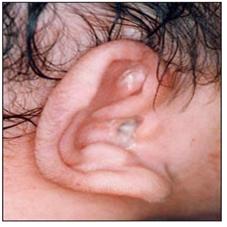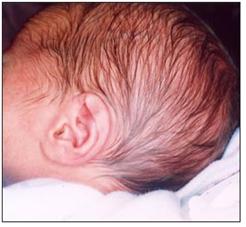신생아의 귀, Ears of newborn infants
- 뱃속에 있는 태아도 크고 작은 소리, 즐거운 음악의 음률을 어느 정도 분별해 들을 수 있다.
- 신생아들도 문을 닫을 때 나는 큰소리나 손뼉 치는 큰소리 등을 쉽게 들을 수 있다.
- 시끄러운 소리에 자다가 깰 수 있다.
- 점잖고 낮고 부드럽고 사랑 하는 말소리를 엄마아빠로부터 듣기 좋아한다.
- 태어나기 전까지 외이도 속에 차있던 양수는 출생 후 1~2시간 내에 다 마른다.
- 신생아들이나 영유아들의 귀를 닦아줄 때 보이지 않는 귓구멍 속 깊이 닦아주어서는 안 된다.
- 엄마의 손가락의 끝이 들어갈 수 있는 한도 외이도 속까지만 손으로 닦아줄 수 있다.
- 귀를 보통으로 닦아줄 때 귓구멍과 외이도 속으로 물이 들어갈까 염려할 필요는 없다. 특히 외이도 속 깊숙한 부위를 면봉으로 후벼 닦아주어서는 안 된다.
- “엄마 아빠의 팔꿈치의 크기보다 더 큰 것만 귓구멍 속에 넣어라”는 말이 있다.

사진 2-156. 갓 태어난 신생아의 귀
귓구멍과 외이도 속에 하얀 태지가 들어있다.
Copyright ⓒ 2012 John Sangwon Lee, MD., FAAP

사진 2-157. 생후 2주된 신생아의 귀와 머리
Copyright ⓒ 2012 John Sangwon Lee, MD., FAAP
|
다음은 “이루공”에 관한 인터넷 소아청소년 건강상담 질의응답의 예 입니다. |
Q&A. 이루공 유전에 대해서
Q.
안녕하세요..
먼저 질문에 대한 답변 감사드리구요, 한 가지 추가로 여쭤 볼께요..
귀기형(외이도 앞쪽에 난 하나의 이루공)은 유전이라고 하셨는데 아기 아빠랑 저는 둘 다 없는데 어떻게 아기한테 생길 수 있는 거죠?
A.
정님께
안녕하세요. 질문해 주셔서 감사합니다. 좋은 질문입니다.
자녀의 나이 , 성별, 과거 병력, 가족 병력, 진찰소견, 임상검사 등의 정보를 많이 알수록 답변을 드리는데 도움이 됩니다. 주신 정보를 토대로 해서 답변을 드리겠습니다.
유전 인자로 유전됩니다.
혈우병과 같은 유전성 질환은 성염색체로 유전 되고 그 외 많은 다른 유전성 질환들은 상염색체로 유전되기도 합니다.
유전에는 우성으로 유전되기도 하고 열성으로 유전되기도 합니다.
상염색체로 유전되는 경우는 남아들이나 여아들에게 다 같은 빈도로 유전될 가능성이 있습니다.
유전학에서 표현율(Penetrance rate)이라는 말이 있다. 그 말은 유전병이 나타날 수 있는 빈도를 말합니다.
많은 유전성 질환이 불완전한 표현율로 나타나는 경우가 있습니다.
저는 유전학을 전문하지 안했습니다.
아기의 기형은 열성 표현 상염색체로 생긴 것 같습니다.
유전학 전문의나 소아청소년과 전문의 또는 이비인후과 전문의에게 문의하시는 것이 어떨까요.
도서관이나 서점에서 유전학 참고서를 참고하시는 것도 좋을 것입니다.
소아청소년과 청소년에서 진단 받으시고 이런 문제에 관해서 상담하시기 바랍니다.
질문이 더 있으면 다시 연락해 주시기 바랍니다. 감사합니다. 이상원 드림
|
다음은“귀에요,,, 부이 ”에 관한 인터넷 소아청소년 건강상담 질의응답의 예 입니다. |
Q&A. 귀에요… 부이
Q.
늦었지만 새해 복 많이 받으세요. *^^*
아이가 태어난 지 40여일 정도 되는데요.
태어나면서부터 귀 쪽에 이상한 것이 있어 궁금했는데 이곳 사이트에 들어와서 궁금증을 해소 했네요.
“부이” 인 것 같거든요. 실로 묶어 두면 해결할 수 있다고 하셨는데요.
너무 어리지 않을까 해서요. 지금 해 주는 것이 좋을지 아니면 조금 더 자란 다음에 해 주는 것이 좋을지 시기를 알 수가 없어서 문의 드려요.
첫아이 때에는 그런 것이 없어서 몰랐는데 처음엔 너무 당황하고 속상해서 어떻게 해야 할지를 몰랐어요. 자세히 알려 주시면 감사하겠습니다.
A.
정원께
안녕하세요. 질문해 주셔서 감사합니다. 좋은 질문입니다.
자녀의 나이 , 성별, 과거 병력, 가족 병력, 진찰소견, 임상검사 등의 정보를 많이 알수록 답변을 드리는데 도움이 됩니다. 주신 정보를 토대로 해서 답변을 드리겠습니다.
부이의 크기, 수, 폭, 피부층에 접한 부이 뿌리의 크기, 자녀의 나이 등에 따라 치료를 다르게 할 수 있습니다.
어떤 부이는 상당히 크기 때문에 간단한 수술로 동네 소아청소년과에서 치료할 수 없습니다. 제가 실로 매어 치료한 부이 기형의 경우, 출생 후 바로 병원 신생아실에서 실로 매어 치료한 예입니다.
일반적으로 유치원에 들어갈 때쯤 부모도 자녀도 수술해 부이를 떼어 내고 싶으면 이비인후과에서 수술 치료를 받을 수 있습니다.
그 전에도 수술 치료를 받을 수 있지만 병원에 입원해야 할 경우도 있고 수술로 인한 세균 감염과 그로 인한 감염병이 생길 가능성이 더 있다는 것을 참작해서 좀 더 큰 후 수술 치료받는 것이 일반적입니다.
이 정도로 조그마한 선천성 기형은 생명에도 위험성이 없고 어떤 때는 이 기형으로 더 예쁘게 보일 수도 있고 그 아이 자신이 그것에 대해서 무관심하지만 부모들이 그것에 신경을 더 많이 쓰는 경우가 있습니다.
완전히 치료 받을 때까지 머리카락으로 부이 있는 그쪽을 가릴 수 있게 머리 손질을 적절히 해 주면 그런 귀 기형이 남들에게 잘 보이지 않을 수 있습니다.
소아청소년과에서 진찰 진단을 받으시고 이 문제에 대해서 상담하시기 바랍니다.
질문이 더 있으시면 다시 연락 주시기 바랍니다. 감사합니다. 이상원 드림
Ears of newborn infants
• Even the fetus in the womb can hear loud and small sounds and pleasant music to some extent.
• Even newborns can easily hear loud noises or clapping hands when the door is closed.
• Loud noises can wake newborns up.
• newborns like to hear gentle, low, soft, loving words from my mom and dad.
• The amniotic fluid that was filled in the external ear canal before birth dries up within an hour or two after birth.
• When cleaning the ears of newborns or infants, do not wipe deep into the invisible ear canal.
• As long as the tip of the mother’s finger can fit into the inside of the ear canal, you can clean it with your hand.
• There is no need to worry about water getting into the external ear canal and the middle ear during regular ear cleaning. In particular, do not wipe the area deep inside the external ear canal with a cotton swab.
• There is a saying, “Put only something that is larger than the size of Mom and Dad’s elbow into the external ear canal.”

Picture 2-156. Newborn baby ears .
White vernix is contained in the external ear canal and external auditory meatus. Copyright ⓒ 2012 John Sangwon Lee, MD., FAAP

Picture 2-157. Ears and head of a two-week-old newborn. Copyright ⓒ 2012 John Sangwon Lee, MD., FAAP
The following is an example of a Q&A for health counseling for children and adolescents on the Internet about “Irugong”.
Q&A.
About preauricular sinus
Q. Good morning. First of all, thanks for the answer to the question, I have one more question. You said that ear deformity (single preauricular sinus in the front of the ear canal) is hereditary.
A. to Jung Good morning.
Thanks for asking. That’s a good question. The more information you know about your child’s age, gender, past medical history, family history, examination findings, and clinical tests, the more helpful it is to give you an answer.
We will give you an answer based on the information you provided.
It is inherited as a genetic factor. Hereditary disorders, such as hemophilia, are inherited as sex chromosomes, and many other hereditary disorders are also inherited autosomal. Inheritance is either inherited as dominant or inherited as recessive.
In cases of autosomal inheritance, it is likely that both boys and girls are inherited at the same frequency.
In genetics, there is a term called the expression rate. That means the frequency at which a hereditary disease can appear. Many hereditary diseases often present with an incomplete expression.
I didn’t specialize in genetics. The malformation in babies appears to be caused by a recessive expressing autosomal.
Why not ask a geneticist, pediatrician, or otolaryngologist? You may want to consult a genetics reference book in your library or bookstore.
Please be diagnosed with children and adolescents and consult about these issues. If you have any further questions, please contact us again.
Thank you. Lee Sang-won. MD
The following is an example of an Internet pediatric health consultation
Q&A regarding on accessory ear, Buoy”.
Q&A.
It’s an ear… buoy
Q.
Late but Happy New Year. *^^*
It’s been about 40 days since the baby was born.
I’ve been curious about something strange in my ears since I was born, but I came to this site and solved my doubts.
I think it’s a “buoy”. You said you could fix it by tying it up with a thread. I was afraid I might be too young. I don’t know when it’s better to do it now or if it’s better to do it after I grow up a little bit, so I’m asking. When I was my first child, I didn’t know anything like that, but at first I was so embarrassed and upset that I didn’t know what to do. Any details would be appreciated.
A.
To the garden Good morning. Thanks for asking.
That’s a good question. The more information you know about your child’s age, gender, past medical history, family history, examination findings, and clinical tests, the more helpful it is to give you an answer.
We will give you an answer based on the information you provided.
Treatment may vary depending on the size, number and width of the buoys, the size of the roots of the buoy in contact with the skin layer, and the age of the child. Some buoys are quite large and cannot be treated with a simple surgery at your local pediatric department. In the case of a accessory ear deformity that I treated with thread, it is an example that was treated by threading in the hospital neonatal room immediately after birth.
In general, by the time they enter kindergarten, if both parents and children want surgery to remove the buoy, they can receive surgical treatment at the otolaryngology department. You can receive surgical treatment before that, but in some cases you may need to be hospitalized, and it is common to have a bigger surgery after taking into account that there is a higher chance of bacterial infection and infection caused by surgery.
A congenital anomaly this small is not life-threatening, and sometimes it can look prettier, and the child himself is indifferent to it, but parents pay more attention to it.
Such ear deformities may be less visible to others if the hair is properly groomed so that the buoy is covered with hair until fully healed.
Please get a diagnosis from the clinicst of Pediatrics and discuss this problem. If you have more questions, please feel free to contact us. Thank you. Lee Sang-won
출처 및 참조문헌
- Nelson Textbook of Pediatrics 22ND Ed
- The Harriet Lane Handbook 22ND Ed
- Growth and development of the children
- www.drleepediatrics.com 제1권 소아청소년 응급 의료
- www.drleepediatrics.com 제2권 소아청소년 예방
- www.drleepediatrics.com 제3권 소아청소년 성장 발육 육아
- www.drleepediatrics.com 제4권 모유,모유수유, 이유
- www.drleepediatrics.com 제5권 인공영양, 우유, 이유식, 비타민, 미네랄, 단백질, 탄수화물, 지방
- www.drleepediatrics.com 제6권 신생아 성장 발육 육아 질병
- www.drleepediatrics.com제7권 소아청소년 감염병
- www.drleepediatrics.com제8권 소아청소년 호흡기 질환
- www.drleepediatrics.com제9권 소아청소년 소화기 질환
- www.drleepediatrics.com제10권. 소아청소년 신장 비뇨 생식기 질환
- www.drleepediatrics.com제11권. 소아청소년 심장 혈관계 질환
- www.drleepediatrics.com제12권. 소아청소년 신경 정신 질환, 행동 수면 문제
- www.drleepediatrics.com제13권. 소아청소년 혈액, 림프, 종양 질환
- www.drleepediatrics.com제14권. 소아청소년 내분비, 유전, 염색체, 대사, 희귀병
- www.drleepediatrics.com제15권. 소아청소년 알레르기, 자가 면역질환
- www.drleepediatrics.com제16권. 소아청소년 정형외과 질환
- www.drleepediatrics.com제17권. 소아청소년 피부 질환
- www.drleepediatrics.com제18권. 소아청소년 이비인후(귀 코 인두 후두) 질환
- www.drleepediatrics.com제19권. 소아청소년 안과 (눈)질환
- www.drleepediatrics.com 제20권 소아청소년 이 (치아)질환
- www.drleepediatrics.com 제21권 소아청소년 가정 학교 간호
- www.drleepediatrics.com 제22권 아들 딸 이렇게 사랑해 키우세요
- www.drleepediatrics.com 제23권 사춘기 아이들의 성장 발육 질병
- www.drleepediatrics.com 제24권 소아청소년 성교육
- www.drleepediatrics.com 제25권 임신, 분만, 출산, 신생아 돌보기
- Red book 29th-31st edition 2021
- Nelson Text Book of Pediatrics 19th- 21st Edition
- The Johns Hopkins Hospital, The Harriet Lane Handbook, 22nd edition
- 응급환자관리 정담미디어
-
소아가정간호백과–부모도 반의사가 되어야 한다, 이상원
-
Neonatal Resuscitation American heart Association
-
Neonatology Jeffrey J.Pomerance, C. Joan Richardson
-
Pediatric Resuscitation Pediatric Clinics of North America, Stephen M. Schexnayder, M.D.
-
Pediatric Critical Care, Pediatric Clinics of North America, James P. Orlowski, M.D.
-
Preparation for Birth. Beverly Savage and Dianna Smith
-
Infectious disease of children, Saul Krugman, Samuel L Katz, Ann A. Gershon, Catherine Wilfert
- 소아과학 대한교과서
- Other
|
Copyright ⓒ 2015 John Sangwon Lee, MD., FAAP 미국 소아과 전문의, 한국 소아청소년과 전문의 이상원 저“부모도 반의사가 되어야 한다”-내용은 여러분들의 의사로부터 얻은 정보와 진료를 대신할 수 없습니다. “The information contained in this publication should not be used as a substitute for the medical care and advice of your doctor. There may be variations in treatment that your doctor may recommend based on individual facts and circumstances. “Parental education is the best medicine.” |